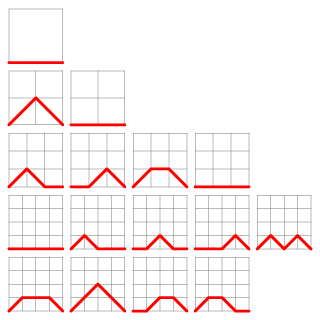05AB1E, 13 12 bytes
ÝI<ãʒ.øDŸQ}g
Try it online!
While most answers use a formula or recurrence relation, this is a simple counting approach.
Each possible path through the grid is represented by the list of its y coordinates. For n segments, there are a total of (n+1) points, but the first and last one are necessarily 0, so that leaves (n-1) points to specify.
Ý # range [0..n]
I< # n - 1
ã # cartesian power
We now have a list of paths (not yet including the initial and final 0). By construction, none of them ever go below 0. However, some of them have illegal slopes (e.g. jump from 0 to 2), so we need to filter them out.
ʒ }g # count how many paths satistfy the following condition
0.ø # surround with 0
Q # is equal to
DŸ # its own fluctuating range
Ÿ is the fluctuating range built-in. If there's any pair of non-adjacent numbers, it will fill in the missing numbers (e.g. [0, 2] becomes [0, 1, 2]). Only legal paths will be left unchanged.
A perhaps more intuitive way to check for illegal slopes would be üαà (assert the maximum of pairwise absolute differences equals 1). However, this misses the flat [0, 0, ... 0] path, which costs one extra byte to fix.
Finally, note that the actual code uses .ø where this explanation uses 0.ø. Instead of surrounding the path with 0s, this surrounds the implicit input with two copies of the path. This turns the coordinate system upside-down and inside-out, but is otherwise equivalent.





What's the minimum set of Motzkin numbers we must be able to generate? – Addison Crump – 2015-12-17T08:09:43.900
2Related – Mego – 2015-12-17T08:15:45.890
@FlagAsSpam All of them, up to limitations of time/memory/data type. – isaacg – 2015-12-17T08:35:16.433
I think languages need a Dyck words builtin now. – lirtosiast – 2015-12-17T16:21:31.053